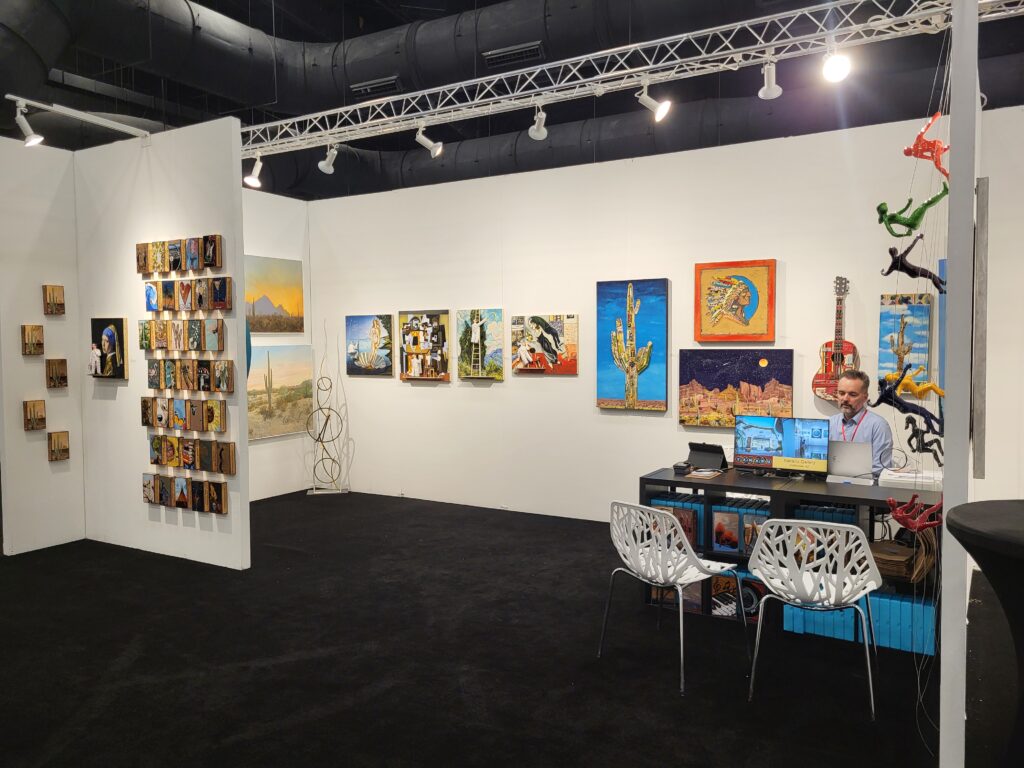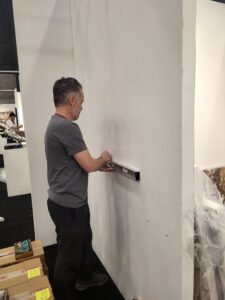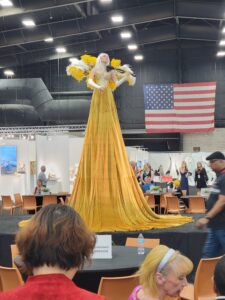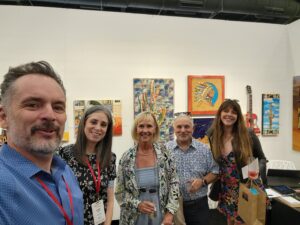
This March, Xanadu Gallery participated in its first high-end art fair, and what an experience it was. Over the years, we’ve participated in several outdoor art festivals, but never a large-scale, gallery-centric art fair. That changed with the inaugural Scottsdale Ferrari Art Week. The experience was intense, energizing, and ultimately educational—and we came away with valuable insights we’re eager to share.

Art Fairs vs. Art Festivals: Clearing Up the Confusion
Before diving into the experience itself, it’s worth clearing up a common confusion I noticed not just among artists, but among patrons as well: the difference between an art fair and an art festival. These terms are often used interchangeably, but they refer to very different kinds of events.
Art festivals are typically outdoor events in parks or civic spaces, made up mostly of individual artists who each bring their own tents, walls, and displays. Entry is usually free or inexpensive for attendees, and booth fees for artists might range from $200 to $1,000 depending on the event’s prominence.
Art fairs, by contrast, are more formal, typically indoor events. They’re often held in convention centers or large temporary tent structures. These events are gallery-focused, and the audience is typically made up of serious collectors and high-end art buyers. Booth fees can range from several thousand to well over $100,000. The Scottsdale Ferrari Art Week, hosted at WestWorld (home of the Barrett-Jackson car auctions), followed this model. Entry fees for attendees started at $50 and went up to $300 for the VIP opening night.
Discovering the Opportunity
It was our gallery director, Kristin, who first came across a mention of the fair. She flagged it for us, and we decided to look into it further. I filled out the application with curiosity more than commitment, but was quickly contacted by one of the event organizers—a Scottsdale gallery owner who was spearheading the fair with help from experienced art fair professionals. He spent nearly an hour on the phone with me, explaining the concept, the intended audience, and the opportunity it represented. He also, quite skillfully, sold me on the idea.
Ultimately, we decided the potential rewards—in terms of sales, exposure, and especially education—were worth the risk. The financial commitment was not small. The base cost for the smallest booth (10′ x 20′) was just the beginning. Add in wall modifications, extra lighting, electricity, marketing fees, and so on, and our total investment ended up at $9,171.20.
Preparing for the Fair
Participating in an art fair requires serious preparation, and we started early. The booth package came with a back wall and two side walls, eight lights, and a painted surface for display. We opted to add a 6-foot front wall to help define the space and create additional hanging area. Every extra element had a cost—$100 per linear foot of wall, $100 per light, and even $125 just to have access to a power outlet.
Selecting which artworks to show turned out to be one of the more complex decisions. On one hand, we wanted to showcase strong, sellable work from our most successful artists. On the other, we didn’t want to deplete the gallery during our busy Scottsdale season. So we worked with several of our artists to secure additional inventory specifically for the event. We focused on a mix of high-appeal original works and lower-priced, high-turnover items like Spiritiles.
We planned carefully and divided up the work in the weeks leading up to the fair. By the time setup day arrived, we were ready.
Setup Day: Organized Chaos
Carrie and I coordinated the transport and setup of the booth

. The space was carpeted, but the floor was covered in dust and debris from the booth construction and painting process. Surprisingly, no vacuuming had been done, and the organizers had only a couple of rechargeable vacuums on hand. So on Thursday morning, we brought our own vacuum from home. Not only did we clean our booth, but neighboring galleries quickly borrowed it to clean their own spaces as well.
Our layout included a work desk, a computer, and a full point-of-sale system. While many other exhibitors brought only small tables or none at all, we found having a full workstation to be incredibly helpful. It allowed us to stay organized, print receipts, manage sales, and take notes throughout the day.
The Fair Begins: Engaging Every Step of the Way

From the moment the doors opened on Thursday morning, the pace was relentless. Our team staffed the booth throughout the event, staying on our feet and engaging constantly with potential buyers.
Our approach was simple: engage with everyone. If someone walked within 30 feet of our booth, we made eye contact, started a conversation, and invited them in. That proactive attitude paid off immediately. Within the first hour of the preview event, we sold our first Spiritile. These smaller items, priced at $200, proved essential in getting momentum going and encouraging multi-item purchases.
Each day followed a similar pattern: steady traffic, lots of conversation, and multiple sales. We were surprised to see that some other booths weren’t even staffed when the show opened. Many exhibitors took a more passive approach, which left us scratching our heads. If you’ve paid thousands of dollars to be there, why wouldn’t you take advantage of every single moment?
We also used the fair as an opportunity to meet new collectors—many of whom lived right in Scottsdale and had never been to our gallery. It was more effective than any ad we could have run.
Sales, Connections, and Takeaways
We made sales every day, including several larger original works. Our total sales came in at $20,084.32. After paying artists, our net profit was $1,991.50. Modest? Yes. But that doesn’t account for the significant follow-up potential. We’ve already had additional sales and gallery visits from people we met at the fair.
We also got visits from organizers of other art fairs (Aspen, Miami, and others), and it wouldn’t surprise me if we receive invitations to future events.

Lessons Learned (and Reaffirmed)
- Be proactive. Don’t wait for people to come to you. Go to them.
- Have a range of price points. Our Spiritiles were key to getting early sales.
- Bring the right tools. A desk, a computer, a vacuum—they all mattered.
- Wear comfortable shoes. You’ll be on your feet all day. Plan accordingly.
- Stay fully engaged. Every interaction counts.
Will We Do It Again?
Yes. We plan to participate again next year. And we’ll be better prepared, both logistically and strategically. This first experience gave us valuable insight into a different segment of the art market, introduced us to hundreds of new collectors, and reinforced what we already know: success at events like these isn’t about just showing up. It’s about showing up ready to work.
Thank you for your honest and very transparent feedback of this new fair to our fine state! As an emerging artist trying to find her clientele, it’s SO helpful to hear your experience without all the usual “social” hype!
Congrats on your successful event. Sounds like great potential for additional opportunities and new contacts.
Hi Jason,
I am coming at this from a different angle. For 30 years my husband and I have directed and promoted something between an art fair and an arts festival in New England. Booths range from about $1000 (10 x 10 feet) to over $2000 for much larger spaces. The artists construct their own booths and bring their own lighting. They are juried, and a include mix of fine art and curated high-end contemporary craft (design, really). Some of our exhibitors have been with us for 25-30 years and have quite successful, profitable shows with us. Many travel long distances to exhibit with us – even cross-country. The fine art is generally priced between $1000 and $10,000.
I don’t exhibit my own art in fairs, even my own. I can’t wear two hats. And much of my work is priced in the 20,000 – 30,000 range. I would be curious to know what price ranges you were able to sell at this event. It wasn’t clear from your post.
I know some gallery owners who have participated in satellite shows at Art Basel Miami. Most don’t really make a profit but if they continue it seems to be because of the networking.
Really interesting, thank you for sharing your experience with us. I guess your interaction and involvement depends on whether it’s your own business. I really enjoy the art markets that I’m doing, right at the other end of the scale.
Did intl fairs for decades in different countries. They are absolutely relentless in terms of number of contacts to be made. Some of the best contacts will be your fellow vendors especially if the goal is to expand your outreach by associations with other dealers. The clients are very diverse and it is often good to have staff that speak several languages and payment systems that can effectively deal with different currency transactions. Many of the clients will attend numerous art fairs each year and are seasoned buyers who have learned to purchase immediately. prices would range from 1000 to maybe 500,000 for works on hand with the goal being to pay off the booth and display costs from show sales with the profit coming from post exhibit follow ups.
Sounds like the scottsdale fair you attended would be less intl and more usa regional where the client contacts would be easier to achieve sales from followups without further travel costs. Engagement with clients and other vendors is a must if you are going to survive the show circuit, in that it is no different than art markets just higher values and more fast paced. . it is a business model that requires thinking on ones feet and reacting to the clients immediately. As both an artist and gallery owner/dealer i enjoyed these shows as they effectively condensed the time required to make contacts/sales happen. Somewhat like wading into the stream fly fishing as opposed to standing at the bank casting into the creek that flows past your house, both valid however a quite different experience.
I highly respect your willingness to try out the different avenues and the rare willingness to share your observations and results. few others would be as forthcoming or as willing to risk their resources on unknown processes.
Thank you for sharing your experience. And your openness is so wonderfully Refreshing.